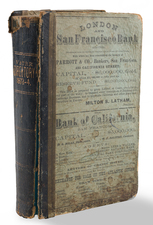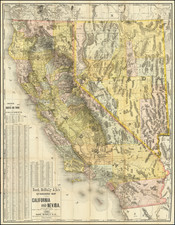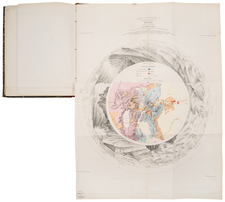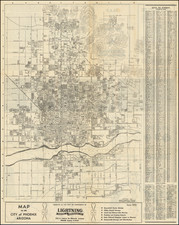
Extremely rare set of 14 maps and 7 profiles, published by the US Geological Survey in 1924, in connection with the preliminary investigations for the Boulder Dam Project.
This set includes the maps and profiles created by Claude H. Birdseye and R.W. Burchard duing their 1923 Expedition. This survey and 2 others were completed by the USGS between 1902 and 1923. From the 3 surveys, a total of 63 plans and profiles of the river were created and published in a series of 3 volumes.
The 1923 expedition, led by Claude Birdseye, was the last of the major government surveys on the Colorado River. The final result of the surveys was 5 foot different from the earlier survey.
As noted in the Boulder Canyon Project Final Reports:
Reconnaissance surveys along the lower course of the Colorado River were initiated by the Hydrographic Branch of the United States Geological Survey as early as 1901 , prior to the organization of the Reclamation Service. In December 1901 and January 1902, hydrographers J. B. Lippincott and Jeremiah Ahern made a boat trip from Needles, California, to Yuma, Arizona; and in October 1902, the former made a similar reconnaissance between Gregg's Ferry and Needles, the section of the river which includes Boulder and Black canyons, Boulder Canyon being a few miles up stream from Black Canyon. Mr. Lippincott's report pointed out the availability of dam sites in both of these canyons and the possibility of obtaining large storage capacities in the Virgin and the Colorado River valleys above Boulder Canyon.
In April, 1920, Homer Hamlin and Edgar T. Wheeler made a reconnaissance survey of Colorado River, by boat, covering the section between the mouth of Virgin River and Yuma. During the following November, another reconnaissance was made by the director , chief engineer, and other engineers of the Reclamation Service. As a result of these examinations, it was concluded that the only possible sites for a dam of the height required were to be found in either Boulder or Black Canyon.
Topographic surveys of areas adjacent to the lower Colorado River were made by the United States Geological Survey during 1902 and 1903. These surveys covered the section of the river between the International Boundary, at the lower end of Yuma Valley, and Cottonwood Canyon, about 400 miles up stream. They included the Yuma, Cibola, Blythe, Parker, Chemehuevis, and Mojave valleys; the various intervening canyons; and Bull's Head Canyon, upstream from Mojave Valley, where a proposed site for a storage dam was investigated by diamond drilling in 1903 and 1904. Maps were prepared on a scale of 1,000 feet to 1 inch , with a contour interval, generally, of 5 feet.
The topographic surveys of the proposed reservoir site upstream from Boulder Canyon, started in 1919, marked the beginning of detailed field investigations for the Boulder Canyon Project. These surveys, also made by the United States Geological Survey, covered the basin formed at the junction of the Virgin and Colorado rivers and extended up both rivers. They were later extended downstream to include Boulder Canyon, the Las Vegas- Callville Basin, and the upper part of Black Canyon.
The surveyors were compelled to use the river as a means of transportation on much of the work, since the surrounding terrain was too rough and precipitous for travel by land. The reaches of the river included in the survey contained dangerous rapids which presented obstacles to navigation. It was possible to portage around some of the rapids, and to line the boats through at places where talus slopes existed along the canyon walls. However, at some locations, where the cliffs rose abruptly from the edges of the river, the only feasible route was through the rapids. In spite of the transportation, difficulties encountered, the required topographic measurements were secured and the major part of the surveys completed in 1920.
As finally completed, the survey covered practically the entire reservoir area enclosed by the contour at elevation 1250 feet above sea level. Maps were prepared on a scale of 2 inches to the mile, with a contour interval of 50 feet. They were subsequently published by the United States Geological Survey as parts of a series entitled “Plan and Profile of the Colorado River from Lee's Ferry to Black Canyon.” Although of sufficient accuracy for most practicable purposes, so far as valley areas were concerned, the topographic data secured along the canyon walls was more or less of a general nature. Consequently, more detailed topographic surveys of locations tentatively considered more satisfactory for the construction of a high dam, were made by the Reclamation Service in 1922 and 1923, while conducting foundation drilling operations at alternative dam sites . Contour maps prepared on the basis of these surveys were used in developing preliminary de signs and preparing cost estimates.


![[ Utah Territory and the Great Plains ] Maps / Stansbury's Expedition / Map of the Great Salt Lake and Adjacent Country in the Territory of Utah . . . (and) Map of a Reconnaissance between Fort Leavenworth on the Missouri River and the Great Salt Lake of Utah made in 1849 and 1850 . . .](https://storage.googleapis.com/raremaps/img/small/88490.jpg)

![[Salt Lake City] Great Salt Lake, Utah](https://storage.googleapis.com/raremaps/img/small/67335.jpg)

